The Path to Peace and Happiness in a Global Society
Vilnius, Lithuania, 13 September 2013 - At the Academy of Arts once more, the first of His Holiness the Dalai Lama’s engagements today was a meeting with Buddhists and supporters of Tibet. He began by paying his respects before an image of the Buddha that had been set up to one side of the dais. He explained that today the Buddha is commonly regarded as a symbol of compassion. However, to begin with he was a sentient being who clarified his mind, cleansing it of defilements, gradually overcoming all mistaken conceptions and acquiring wisdom through the application of intelligence. 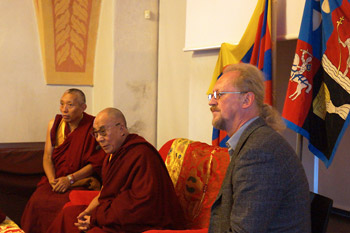
| His Holiness the Dalai Lama speaking to Buddhists and supporters of Tibet at the Academy of Arts in Vilnius, Lithuania on September 13, 2013. Photo/Jeremy Russell/OHHDL
|
In ancient India the practice of morality, single pointed concentration and penetrative wisdom were the three trainings common to spiritual practice. The Buddha considered that the defiled mind was the source of many of our problems, the crucial aspect being the ignorance that involved a conception of the self as an independent entity. To counter it he taught about selflessness, the self’s lack of inherent existence. The idea that the self exist as an independent entity is the source of our problems and the root of our destructive emotions.
“If an independent self exists,” His Holiness explained, “we should be able to find it when we look for it. But wherever we look, from the crown of our heads to the soles of our feet, we don’t find it. If we think of the self as synonymous with awareness, where would it be when we fall asleep or faint? Unable to locate it, our idea of a self that is something solid and independent appears to be wrong. ‘Therefore’, the Buddha said, ‘the existence of self is merely designated on the basis of the five psycho-physical aggregates that make up a human being, just as a chariot is designated on the basis of its parts.’”
This does not mean, however, that the self does not exist at all; it does have a conventional or relative existence, not an existence as something independent or absolute. When we develop anger we have a strong sense of self while the object of our anger seems entirely negative. This complies with the American psychotherapist, Aaron Beck’s observation that this negativity is 90% our own mental projection. If something were absolutely negative, everyone should see it that way, and they do not.
“How do we overcome ignorance, by praying to the Buddha? - No, by following the path he showed. As he said, ‘you are your own master’. The Buddha didn’t say, I’m the Buddha, pray to me, he taught the Four Noble Truths: suffering, its cause, cessation and the path to it. He taught about lasting peace that can only be achieved through practice. His whole teaching is based on the law of cause and effect; if you want change, create the causes.”
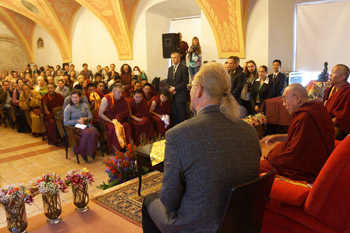
| His Holiness the Dalai Lama speaking to Buddhists and supporters of Tibet at the Academy of Arts in Vilnius, Lithuania on September 13, 2013. Photo/Jeremy Russell/OHHDL
|
His Holiness pointed out that within Buddhism are the Pali and Sanskrit traditions. The Sanskrit tradition focusses on the Perfection of Wisdom sutras. Followers of the Chinese, Japanese, Korean, Vietnamese, Tibetan and Mongolian traditions all recite the Heart Sutra. The first turning of the wheel of dharma dealt with the Four Noble Truths, the second turning of the wheel of dharma dealt with the Perfection of Wisdom sutras, and the third turning of the wheel of dharma dealt with the clarity of the mind and the path of the Fourth Noble Truth.
Buddhism came to Tibet in the 7th century with the marriage of the Emperor Songtsen Gampo to Chinese and Nepalese princesses who both brought images of the Buddha with them. In the 8th century the Tibetan Emperor decided to focus on Buddhist teachings originating in India. He invited Nalanda University’s top scholar Shantarakshita to Tibet. He was a great scholar, a monk and an exemplary master of philosophy and logic. On his initiative translation of Pali and Sanskrit texts into Tibetan began. Padmasambhava was also invited and brought secret teachings with him, although references to tantra in Shantarakshita’s Compendium of Thusness reveal that he practised tantra too. His Holiness objected that some western scholars and other Buddhists say the Mahyana was not taught by the Buddha and that Buddhist tantras do not exist, but there is evidence that Nagarjuna, Aryadeva and Atisha were all practitioners of tantra.
“Tibetan Buddhism is a complete form of Buddhism. When we Tibetans meet monks from Thailand, Burma and Sri Lanka, we have the code of monastic discipline, the Vinaya, in common. When we meet Chinese Buddhists and so on we have the Perfection of Wisdom teachings in common, and with Japanese and Chinese Buddhists we have the practice of tantra in common. Tibetan Buddhism is more than 1300 years old, and we owe all our knowledge to Indian masters.”
Turning his attention to the supporters of the struggle for Tibet, His Holiness described the Tibetan cause as a just cause.
“At this time the activities of Tibet Support Groups world-wide is very helpful. Human memories can be very short; reminders of the issue of Tibet are invaluable. Thank you.”
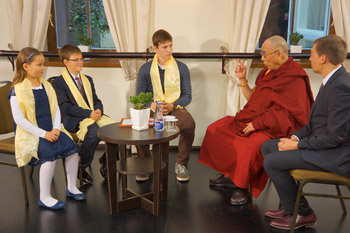
| Three children conducting an interview with His Holiness the Dalai lama for Lrytas TV in Vilnius, Lithuania on September 13, 2013. Photo/Jeremy Russell/OHHDL
|
Among several interviews His Holiness gave, the first was conducted by three children. They asked him how he conducts his morning and he explained that he gets up at 3 am, meditates, has breakfast at 5.30, and continues his meditation until 8.30. When they wanted to know how he gets enough sleep, he confirmed that he goes to bed around 7 pm. They went on to ask about his brothers and sisters - two brothers and one sister survive - and whether he had any other children to play with when he was young - he did while still in his village. They wanted to know what he watches on television and he admitted that he gave up watching about 3 -4 years ago. For news and current event he listens to BBC radio instead.
Next, Rosita Garskaite interviewed him for Bernardinai (a web daily), asking about non-violence. His Holiness made the current circumstances clear:
“In a global society, we are now interdependent, we depend on each other. Therefore, it is no longer appropriate to divide the world into ‘them’ and ‘us’. We need to think of everyone belonging to a great ‘us’. If the world were attacked by aliens, we would unite. We need to work together in a similar way to resist common threats that affect us all.”
His Holiness said that since Mahatma Gandhi used non-violence to such evident effect in the Indian freedom struggle, it has been successfully employed in the Civil Rights movement in the USA and to defeat apartheid in South Africa. Recent events show that whatever your goal, to employ force and violence produces unpredictable results.
Ginas Dabasinskas interviewing His Holiness for Laisvoji Banga (radio) asked about western personalities with whom he feels an affinity and he mentioned Vaclav Havel, Lech Walesa, Bishop Desmond Tutu and Richard Gere, all of whom he counts as friends. When he asked if all people really were equal, His Holiness was categorical in saying “potentially, yes.” He recalled a conversation he had had in Soweto Township in South Africa when an African told him that African brains were inferior to European brains; he resolutely disagreed with him.
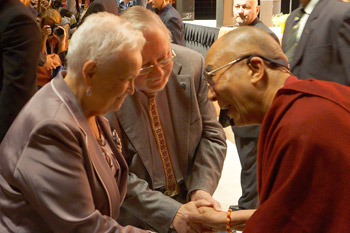
| His Holiness the Dalai Lama greeting the wife of former Lithuanian President Vytautas Landbergis before his talk at the Siemens Arena in Vilnius, Lithuania on September 13, 2013. Photo/Jeremy Russell/OHHDL
|
After lunch with the organizers of his trip to Lithuania, His Holiness drove to the Siemens Arena, the venue of his public talk. Walking onto the stage, he spotted his old friend former President Vytautas Landbergis in the front row with his wife and came down to greet her. Before beginning his talk, he presented the Dalai Lama Award, Youth Compassion to Donatas Semasko for his dedicated volunteer work.
“I am very happy to be here again,” he began, “since my first visit I have had a very good impression of the people of this country, a people whose spirit and sense of truthfulness have remained strong no matter what obstacles they faced.
“Whenever I speak in public, I feel I am just another human being like my listeners, mentally, physically and emotionally the same. When I was younger, I was aware of being the Dalai Lama, which made me somewhat nervous and anxious. However, these days, I am completely relaxed.
“A lot of the problems we face are based on our self-centredness, our emphasis on ‘me’ and ‘us’, which creates a barrier between us and others. Buddhism teaches that everyone has a right to a happy life; we have to work together to achieve it because everything is interdependent. In such circumstances the best way to look after your own interests is to take care of others.”
His Holiness explained that in a global society such as we live in today, peace will not arise as a result of prayer, but through our taking action. Peace must develop first in our hearts. On the basis of our inner peace, we can create a peaceful atmosphere around us and so contribute to peace in the world.
With regard to happiness, His Holiness said:
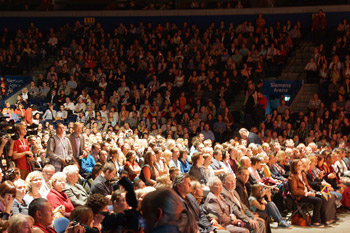
| Some of the over 4,500 people listening to His Holiness the Dalai Lama's talk at the Siemens Arena in Vilnius, Lithuania on September 13, 2013. Photo/Jeremy Russell/OHHDL
|
“If you only rely on material goods, you will not achieve your real goal. Sensory experience alone does not bring lasting inner peace.”
After answering several questions from the audience, His Holiness thanked the organizers for making it possible for such a large number of people, more than 4500, to come together in one place. Appealing to the audience he said:
“Please think over what I’ve been talking about. If you find it interesting, discuss it with others and think about how to put it into effect; on the other hand if you don’t find it interesting, please just forget it. Thank you.”
Tomorrow, His Holiness travels on to Prague in the Czech Republic where he will be teaching the Eight Verses for Training the Mind.  http://www.dalailama.com/
|